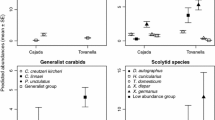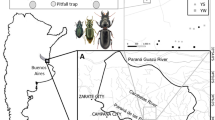Abstract
Tree plantations may play a role in the conservation of global forest biodiversity. At the landscape scale, plantations with a complex understory may provide surrogate habitats for forest-dwelling organisms. This was tested using a manipulative experiment in which the abundance, movement and survivorship of Ceroglossus chilensis (an endemic and flightless ground beetle) was examined in plantation forest stands where the density of the understory vegetation was manipulated. Between 2009 and 2012, we collected C. chilensis by pitfall trapping in nineteen plots with naturally high, naturally low and experimentally removed understory cover. Beetle movement was evaluated by direct observation, and survival was quantified as the proportion of days that individuals survived in closed and open containers half-buried in the soil. C. chilensis exhibited higher abundance in plots with naturally high than with low or experimentally removed understory cover. Beetles traveled shorter distances and preferred to stay in stands with developed understory. C. chilensis had significantly higher mortality by predators in plantations with scarce understory cover. Therefore, forest plantations with a dense understory can become surrogate habitats for C. chilensis, and may contribute to the conservation of its populations.




Similar content being viewed by others
References
Berndt LA, Brockerhoff E, Jactel H (2008) Relevance of exotic pine plantations as a surrogate habitat for ground beetles (Carabidae) where native forest is rare. Biodivers Conserv 17:1171–1185
Brady MJ, Mcalpine CA, Miller CJ, Possingham HP, Baxter GS (2009) Habitat attributes of landscape mosaics along a gradient of matrix development intensity: matrix management matters. Landsc Ecol 24:879–891
Bremer LL, Farley K (2010) Does plantation forestry restore biodiversity or create green deserts? A synthesis of the effects of land-use transitions on plant species richness. Biodivers Conserv 19:3893–3915
Brockerhoff EG, Berndt LA, Jactel H (2005) Role of exotic pine forests in the conservation of the critically endangered New Zealand ground beetle Holcaspis brevicula (Coleoptera: Carabidae). N Z J Ecol 29:37–43
Brockerhoff EG, Jactel H, Parrota JA, Quine CP, Sayer J (2008) Plantation forests and biodiversity: oxymoron or opportunity? Biodivers Conserv 17:925–951
Brose U (2003) Bottom-up control of carabid beetle communities in early successional wetlands: mediated by vegetation structure or plant diversity? Oecologia 135:407–413
Bustamante RO, Grez AA, Simonetti JA (2006) Efectos de la fragmentación del bosque maulino sobre la abundancia y diversidad de especies nativas. In: Grez AA, Simonetti JA, Bustamante RO (eds) Biodiversidad en ambientes fragmentados de Chile: patrones y procesos a diferentes escalas. Editorial Universitaria, Santiago, pp 83–97
Convention on Biological Diversity (2010) Strategic plan for biodiversity 2011–2020 and the Aichi targets. Secretariat of the Convention on Biological Diversity, Montreal. http://www.cbd.int/doc/strategic-plan/2011-2020/Aichi-Targets-EN.pdf. Accessed Dec 2014
Donoso D (2011) Demografía, movimiento y diversidad genética de Ceroglossus chilensis en el bosque Maulino fragmentado. Dissertation, Universidad de Chile, Santiago, Chile
Driscoll DA, Banks SC, Barton PS, Lindenmayer DB, Smith AL (2013) Conceptual domain of the matrix in fragmented landscapes. Trends Ecol Evol 28(10):605–613
Echeverría C, Coomes D, Salas J, Rey-Benayas JM, Lara A, Newton A (2006) Rapid deforestation and fragmentation of Chilean temperate forests. Biol Conserv 130:481–494
Estades CF, Grez AA, Simonetti JA (2012) Biodiversity in Monterey pine plantations. In: Simonetti JA, Grez AA, Estades CF (eds) Biodiversity conservation in agroforestry landscapes: challenges and opportunities. Editorial Universitaria, Santiago, pp 77–98
Ewers RM (2008) Spatio-temporal variation in mortality rates of Mecodema spp. (Coleoptera: Carabidae) across a forest-grassland edge in New Zealand. Insect Conserv Divers 1:40–47
Fahrig L (2007) Non-optimal animal movement in human-altered landscapes. Funct Ecol 21:1003–1015
FAO (2010) Global Forest Resources Assessment 2010. Main Report. FAO Forestry Paper 163, Rome, pp 346
Felton A, Knight E, Wood J, Zammit C, Lindenmayer D (2010) A meta-analysis of fauna and flora species richness and abundance in plantations and pasture lands. Biol Conserv 143:545–554
Goodwin BJ, Fahrig L (2002) Effect of landscape structure on the movement behaviour of a specialized goldenrod beetle, Trirhabda borealis. Can J Zool 80:24–35
Grez AA, Moreno PO, Elgueta M (2003) Coleópteros (Insecta, Coleoptera) epigeos asociados al bosque maulino y plantaciones de pino aledañas. Rev Chil Entomol 29:9–18
Hartley MJ (2002) Rationale and methods for conserving biodiversity in plantation forests. For Ecol Manag 155:81–95
Hawkes C (2009) Linking movement behaviour, dispersal and population processes: is individual variation a key? J Anim Ecol 78:894–906
Haynes KJ, Cronin JT (2006) Interpatch movement and edge effects: the role of behavioral responses to the landscape matrix. Oikos 113:43–54
Henríquez P, Donoso D, Grez AA (2009) Population density, sex ratio, body size and fluctuating asymmetry of Ceroglossus chilensis (Carabidae) in the fragmented Maulino forest and surrounding pine plantations. Acta Oecol 35:811–818
Kuefler D, Hudgens B, Haddad NM, Morris WF, Thurgate N (2010) The conflicting role of matrix habitats as conduits and barriers for dispersal. Ecology 91:944–950
Lange M, Türke M, Pašalić E, Boch S, Hessenmöller D, Müller J, Prati D, Socher SA, Fischer M, Weisser WW, Gossner MM (2014) Effects of forest management on ground-dwelling beetles (Coleoptera; Carabidae, Staphylinidae) in Central Europe are mainly mediated by changes in forest structure. For Ecol Manag 329:166–176
Lindenmayer DB, Hobbs RJ (2004) Fauna conservation in Australian plantation forests—a review. Biol Conserv 119:151–168
Lindenmayer DB, Wood JT, Cunningham RB, Crane M, Macgregor C, Michael D, Montague-Drake R (2009) Experimental evidence of the effects of a changed matrix on conservating biodiversity within patches of native forest in an industrial plantation landscape. Landsc Ecol 24:1091–1103
Lövei G, Sunderland KD (1996) Ecology and behavior of ground beetles (Coleoptera: Carabidae). Annu Rev Entomol 41:231–256
Marascuilo LA (1966) Large-sample multiple comparisons. Psychol Bull 65:280–290
Melbourne BA (1999) Bias in the effect of habitat structure on pitfall traps: an experimental evaluation. Aust J Ecol 24:228–239
Nahuelhual L, Carmona A, Lara A, Echeverría C, González ME (2012) Land-cover change to forest plantations: proximate causes and implications for the landscape in south-central Chile. Landsc Urban Plan 107:12–20
Nájera A, Simonetti JA (2010) Can oil palm plantations become bird friendly? Agrofor Syst 80:203–209
Niemelä J, Koivula M, Kotze DJ (2007) The effects of forestry on carabid beetles (Coleoptera: Carabidae) in boreal forests. J Insect Conserv 11:5–18
Oxbrough A, Irwin S, Kelly TC, O’Halloran J (2010) Ground-dwelling invertebrates in reforested conifer plantations. For Ecol Manag 259:2111–2121
Pawson S, Brockerhoff E, Meenken E, Didham R (2008) Non-native plantation forests as alternative habitat for native forest beetles in a heavily modified landscape. Biodivers Conserv 17:1127–1148
Poch T, Simonetti JA (2013) Insectivory in Pinus radiata plantations with different degree of structural complexity. For Ecol Manag 304:132–136
Prevedello JA, Vieira MV (2010) Does the type of matrix matter? A quantitative review of the evidence. Biodivers Conserv 19:1205–1223
Saura S, Martín-Queller E, Hunter ML Jr (2014) Forest landscape change and biodiversity conservation. In: Azevedo JC, Perera AH, Pinto MA (eds) Forest landscapes and global change: 167 challenges for research and management. Springer, New York, pp 167–198
Silva-Rodríguez EA, Ortega-Solís GR, Jiménez JE (2010) Conservation and ecological implications of the use of space by chilla foxes and free-ranging dogs in a human-dominated landscape in southern Chile. Aust Ecol 35:765–777
Simonetti JA, Grez AA, Estades CF (2012) Biodiversity conservation in agroforestry landscapes: challenges and opportunities. Editorial Universitaria, Santiago
Simonetti JA, Grez AA, Estades CF (2013) Providind habitat for native mammals through understory enhancement in forestry plantations. Conserv Biol 27:1117–1121
Spellerberg IF, Sawyer JWD (1995) Multiple-use, biological diversity and standards. N Z J For 39:21–25
Sweaney N, Lindenmayer DB, Driscoll DA (2014) Is the matrix important to butterflies in fragmented landscapes? J Insect Conserv 18:283–294
van Halder I, Barbaro L, Corcket E, Jactel H (2008) Importance of semi-natural habitats for the conservation of butterfly communities in landscapes dominated by pine plantations. Biodivers Conserv 17:1149–1169
Vergara PM, Simonetti JA (2004) Does nest site cover reduce nest predation upon rhynocriptids? J Field Ornithol 75:188–191
Zar JH (2010) Biostatistical analysis, 5th edn. Prentice Hall, Upper Saddle River
Acknowledgments
This study was supported by Fondecyt 1095046 and Programa Domeyko-Biodiversidad (Iniciativa Transversal 3), Universidad de Chile. We are grateful to the Corporación Nacional Forestal and Forestal Masisa S.A. for allowing us to work on their property. Thanks are due to A. Rodríguez-San Pedro and R. Zúñiga for their field support, and two anonymous reviewers for their cogent criticisms. We are grateful to Cristián Estades for providing some of the images in Fig. 1.
Author information
Authors and Affiliations
Corresponding author
Rights and permissions
About this article
Cite this article
Cerda, Y., Grez, A.A. & Simonetti, J.A. The role of the understory on the abundance, movement and survival of Ceroglossus chilensis in pine plantations: an experimental test. J Insect Conserv 19, 119–127 (2015). https://doi.org/10.1007/s10841-015-9752-y
Received:
Accepted:
Published:
Issue Date:
DOI: https://doi.org/10.1007/s10841-015-9752-y




